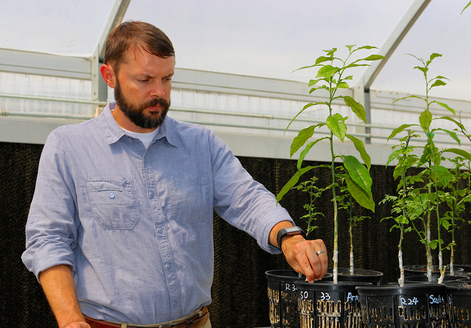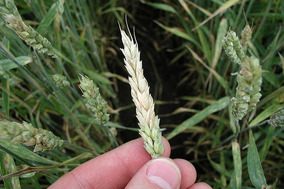|
Having trouble viewing this email? View it as a Web page.

|
|
|
Editor: Kelly Sprute Aug. 8,
2018
Making a Difference
 Jay Speirs with Auburn University.
Agricultural
Research Grants Address Cost, Efficiency
Cost and efficiency are
high on the list of concerns for Alabama farmers and equally high on the list
of priorities for Auburn University researchers. The Alabama Agricultural
Experiment Station’s (AAES) Production Agriculture Research (PAR) grants
program, now in its second year, is committed to finding timely solutions to
problems that may prevent the state’s farmers from being profitable.
Administered through AAES
with NIFA’s Hatch funding and matching state appropriations, the PAR program is
funding nine research projects this year, with a total commitment of $446,138.
“These projects address needs identified by farmers, commodity groups, and
other agricultural stakeholders in Alabama, and cost and efficiency are at the
top of everyone’s list,” said Henry Fadamiro, associate dean for research for
the College of Agriculture and associate director of the AAES. Read the full Auburn University article.
|
|
 USDA Invests $345.5 Million in Rural Electric
Infrastructure to Improve Service in 14 States
Agriculture Secretary
Sonny Perdue recently announced that USDA is investing $345.5 million in
20 infrastructure projects to improve rural electric service for more than
1 million residential and commercial consumers in 14 states.
“Delivering reliable and
affordable electricity to power rural America will help lay the groundwork for
increased rural prosperity and economic opportunity,” Secretary Perdue said.
“USDA is partnering with rural electric utilities and cooperatives so they can
continue to invest in infrastructure improvements to provide electric power to
those who live and work in rural areas.”
USDA is making the
investments through the Electric Infrastructure Loan Program. Read the full USDA press release.
|
 Employing Wheat's
Bacterial Partners to Fight a Pathogen
Fusarium head blight is
a devastating fungal disease affecting wheat and barley crops worldwide.
According to the American Phytopathological Society, this disease has cost U.S.
wheat and barley farmers more than $3 billion since 1990. USDA’s Agricultural Research
Service scientists, together with land managers and other scientists at
research universities, are taking a variety of approaches to solving this
problem. These include breeding resistant cultivars, using massive
disease-forecasting models and applying fungicides during critical junctures in
crop growth to prevent fusarium head blight. Recently, many scientists have
also become interested in the idea of employing microbial species that already
live on and inside crop plants to do the dirty work of controlling disease
epidemics. Read the full USDA blog.
Typical premature
whitening of a wheat head infected with the fungus that causes Fusarium head
blight. Photo by USDA Agricultural Research Service.
|
 Empowering Students
is the Solution
It
is no longer enough for students to be knowledgeable on the subject matter of a
particular major, they must also empowered with the soft skills necessary to
enhance their employability. Prairie View A&M University’s Cooperative
Agricultural Research Center teaches students effective oral communication by
hosting mock oral and poster research symposiums. With globalization having a
profound effect on education, the active and reflective application of
knowledge that innovates better prepares students to compete in their future
careers. Because the exercise focuses on practicing public oral presentation,
the symposiums expose students to opportunities that promote the productive
exchange of ideas and findings in research specific forums as well as
non-scientific communities. Read the full PVAMU article.
|
 NIFA Invests $21
Million to Encourage Low-Income Families to Buy Healthy Food
NIFA
announced 24 grants totaling $21 million to help Supplemental Nutrition
Assistance Program (SNAP) participants increase their purchases of fruits and
vegetables by providing incentives at the point of purchase. The funding comes
from the Food Insecurity Nutrition Incentive (FINI) program, authorized by the
2014 Farm Bill.
FINI is a joint program between NIFA and USDA’s Food and Nutrition
Service, which oversees SNAP and is responsible for evaluating the impact of
the variety of incentive programs that are deployed by FINI grantees. The
program brings together stakeholders from different parts of the national food
system to improve the nutrition and health status of SNAP households. The FINI
program supports a wide range of small pilot projects; multi-year community
programs; and multi-year, large-scale initiatives. Read the full award announcement.
|
NIFA Invests
Nearly $500,000 to help Small Businesses Ensure Healthy and
Productive Forest Ecosystems
NFA
recently awarded five research grants under the Forest and
Related Resources topic area of the USDA’s Small Business Innovation Research
(SBIR) program. SBIR is a highly competitive program that encourages domestic
small businesses to engage in Federal Research/Research and Development
(R/R&D) that has the potential for commercialization. Including qualified
small businesses in the nation's R&D arena that stimulates high-tech
innovation. SBIR strengthens the United States entrepreneurial spirit as it
gains specific research and development needs. These early stage innovation
grants focus on protecting the nation’s forested lands and resources to help
ensure the continued existence of healthy and productive forest ecosystems.
Forest and Related Resources is one of 10 SBIR topic areas.
|
|
|
NIFA’s mission is to invest in and advance agricultural research, education, and extension to solve societal challenges. NIFA’s investments in transformative science directly support the long-term prosperity and global preeminence of U.S. agriculture.
If you wish to submit a news item or information, send an email to NIFAUpdate.
USDA is an equal opportunity lender, provider, and employer.
|
|